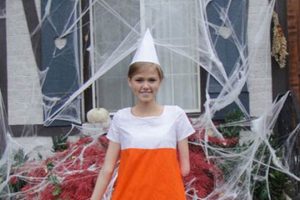The creation of personalized Star Wars-themed attire allows individuals to embody characters from the renowned science fiction franchise through handcrafted methods. This encompasses a wide range of activities, from assembling readily available materials into recognizable outfits to the elaborate construction of detailed replicas utilizing sewing, crafting, and prop-making techniques. For example, a simple Jedi robe can be fashioned from repurposed fabric, while a more ambitious project might involve constructing a Stormtrooper helmet from molded plastic.
Constructing character-based apparel offers several advantages. It provides a cost-effective alternative to purchasing commercially produced merchandise, promotes creativity and resourcefulness, and allows for a higher degree of customization and personalization. Historically, fan-created garments have played a significant role in the Star Wars community, fostering a sense of shared passion and self-expression at conventions, themed events, and everyday occasions. It allows the individual to express their fandom through original designs and innovative adaptation of familiar themes.
The following sections will delve into specific projects, resource recommendations, and techniques to guide individuals through the process of realizing their own galactic visions. Focus will be placed on materials, tools, patterns and techniques useful in constructing a variety of iconic looks from the Star Wars universe.
Tips for Crafting Successful Creations
The construction of self-made Star Wars character representations requires careful planning and execution. The following guidelines offer insights into optimizing the creative process and achieving desired results.
Tip 1: Material Selection is Paramount. Opt for fabrics and materials appropriate for the intended character and environment. For example, a lightweight linen or cotton blend is suitable for Tatooine-based characters, while heavier, more durable materials are preferable for armored individuals.
Tip 2: Prioritize Accuracy and Detail. Reference official images and character guides to ensure accuracy in design and construction. Pay close attention to details such as color palettes, patterns, and accessory placement.
Tip 3: Master Essential Skills. Develop proficiency in basic sewing, crafting, and prop-making techniques. This includes skills such as pattern drafting, fabric manipulation, painting, and weathering.
Tip 4: Utilize Available Resources. Explore online tutorials, forums, and communities for guidance and inspiration. Leverage pre-existing patterns and templates to streamline the construction process.
Tip 5: Focus on Durability and Comfort. Ensure that the finished item is both visually appealing and comfortable to wear for extended periods. Reinforce seams and stress points to prevent damage, and consider the breathability and weight of the materials used.
Tip 6: Embrace Resourcefulness and Repurposing. Consider utilizing repurposed or upcycled materials to reduce costs and promote sustainability. Common household items can often be transformed into key elements of Star Wars character representations.
Tip 7: Conduct Test Fittings and Adjustments. Regularly test-fit the creation during the construction process to identify and address any fit or comfort issues. Make adjustments as needed to ensure a proper and flattering fit.
These tips, when applied diligently, significantly enhance the quality and authenticity of homemade Star Wars-themed garments, resulting in a more satisfying and visually compelling final product. By carefully selecting materials, referencing reliable sources, and mastering essential techniques, individuals can create professional-looking representations of iconic Star Wars characters.
The subsequent sections will address common challenges encountered during the creation process and provide solutions for overcoming them.
1. Material Sourcing
Material sourcing represents a cornerstone of crafting credible Star Wars character representations. The authenticity and overall success of the final product are heavily dependent on the judicious selection and acquisition of appropriate materials.
- Fabric Authenticity
The selection of fabrics resembling those used in original Star Wars films is paramount. Accurate textures, weights, and weaves contribute significantly to the visual fidelity of the character representation. For example, replicating the coarse, sand-worn texture of Tatooine garments requires sourcing materials like linen or loosely woven cotton. Conversely, recreating the sleek, synthetic look of Imperial uniforms may necessitate the use of polyester or nylon blends. Deviation from accurate fabric choices can diminish the overall impact, resulting in a less convincing result.
- Component Functionality
Beyond aesthetics, the functional properties of materials must be considered. If a character requires armor, the selected material should possess the requisite durability and resilience. Options range from molded plastics and fiberglass to more flexible alternatives like EVA foam, each offering a different balance of protection, weight, and ease of shaping. Similarly, prop construction requires selecting materials suitable for intended use and aesthetic requirements.
- Cost-Effectiveness
The budgetary constraints of a project often dictate material choices. While screen-accurate materials may be ideal, more affordable alternatives can often be sourced without significantly compromising the overall look. This might involve repurposing existing garments, utilizing surplus fabrics, or exploring alternative crafting materials. Balancing cost considerations with the desire for authenticity requires careful planning and resourcefulness.
- Ethical and Environmental Considerations
Increasingly, the ethical and environmental impact of material sourcing is becoming a factor. Opting for sustainable fabrics, recycled materials, and locally sourced components can contribute to a more responsible approach to character representation. This can align personal values with the creative process, enhancing the satisfaction derived from the completed product.
The strategic acquisition of appropriate materials constitutes a vital element in producing effective Star Wars character portrayals. Achieving balance between visual fidelity, functionality, budgetary limitations, and ethical considerations is essential to realizing a compelling and meaningful representation of the characters from the Star Wars universe.
2. Pattern Creation
Pattern creation is a fundamental stage in the development of homemade Star Wars character representations. The accurate and efficient construction of garments often relies o
n well-designed patterns, which serve as blueprints for cutting and assembling fabric pieces. Without suitable patterns, achieving authentic and well-fitting results can be significantly challenging.
- Drafting Techniques
Drafting patterns involves creating custom designs based on individual measurements and desired garment specifications. This approach allows for precise tailoring and ensures a comfortable fit. For example, drafting a pattern for a Jedi tunic requires knowledge of basic pattern-making principles, including establishing a sloper (a basic fitted pattern) and adapting it to the tunic’s specific design elements, such as the wide sleeves and overlapping front panels. Accurate measurements and careful calculations are crucial for achieving a well-proportioned and aesthetically pleasing result.
- Commercial Patterns Adaptation
Adapting pre-existing commercial patterns represents a viable alternative to drafting from scratch. This involves selecting a pattern that closely resembles the desired Star Wars garment and modifying it to incorporate specific design features. For instance, a basic jumpsuit pattern can be adapted to create a Rebel pilot flight suit by adding details such as pockets, straps, and quilted panels. Careful attention must be paid to altering the pattern proportionally and ensuring that the modifications align with the intended character’s appearance.
- Digital Pattern Resources
The availability of digital pattern resources has expanded the accessibility of pattern creation for Star Wars representations. Online marketplaces and communities offer a wide range of digital patterns specifically designed for iconic Star Wars garments and accessories. These patterns can be downloaded, printed, and assembled, providing a convenient and cost-effective starting point for construction. However, it is crucial to verify the accuracy and quality of digital patterns before use, as the quality can vary significantly.
- Scaling and Grading Considerations
When adapting or creating patterns, it is essential to consider scaling and grading issues. Scaling refers to adjusting the pattern size to fit different body measurements, while grading involves modifying the pattern proportions to maintain aesthetic balance across sizes. Failing to address these considerations can result in garments that are either ill-fitting or disproportionate. For example, simply increasing the overall dimensions of a pattern may not adequately accommodate variations in torso length or shoulder width, leading to a poorly fitting garment.
The effective integration of pattern creation techniques is essential for achieving successful Star Wars character representations. Whether drafting patterns from scratch, adapting commercial patterns, or utilizing digital resources, attention to detail, accurate measurements, and a thorough understanding of garment construction principles are crucial for realizing authentic and well-fitting garments.
3. Construction Techniques
The tangible manifestation of do-it-yourself Star Wars character representations hinges directly on employed construction techniques. These techniques dictate the structural integrity, visual accuracy, and overall quality of the finished product. A poorly executed seam, for instance, can compromise the durability of a garment, while imprecise prop assembly can detract from its authenticity. For example, crafting a Stormtrooper helmet requires skills in plastic molding, cutting, and joining. Improperly bonded seams may lead to separation under stress, rendering the helmet unusable. Similarly, constructing a lightsaber hilt necessitates knowledge of metalworking, wiring, and finishing. Faulty wiring can result in a non-functional prop, while poor finishing can diminish its aesthetic appeal. The selection and correct application of construction techniques are, therefore, not merely supplementary but fundamentally essential to the successful creation of Star Wars character-based garments and props.
Consider the diverse range of skills needed to realize different characters. A Jedi robe requires proficiency in sewing, hemming, and draping, skills that ensure the fabric flows correctly and the garment hangs naturally. Darth Vader’s armor, conversely, demands expertise in vacuum forming, painting, and assembling multiple components into a cohesive and durable whole. Furthermore, weathering techniques, such as dry brushing and sanding, are essential for imparting a sense of realism and battle-worn authenticity. The ability to execute these techniques with precision and artistry elevates the creation from a simple costume to a recognizable and believable representation of a Star Wars character. Instruction from online tutorials, participation in crafting communities, and experimentation with various materials and methods all contribute to mastering these essential skills.
In summary, proficient execution of construction techniques directly determines the success of homemade Star Wars character representations. Challenges may arise from limited access to specialized equipment or a lack of prior experience. However, dedication to learning and refining these techniques, combined with careful planning and resourcefulness, can yield remarkable results. Ultimately, understanding and mastering construction techniques empowers individuals to transform their creative visions into tangible and impressive representations of beloved Star Wars characters.
4. Prop Fabrication
Prop fabrication serves as a critical component within the realm of do-it-yourself Star Wars character representations. The presence of accurately replicated or creatively interpreted props significantly enhances the visual impact and perceived authenticity of these creations. This connection stems from the understanding that many Star Wars characters are defined not only by their garments but also by the iconic weapons, tools, and accessories they wield or utilize. Consequently, successful character embodiment frequently necessitates the integration of fabricated props. The absence of these elements often results in an incomplete or less compelling portrayal. For instance, a Luke Skywalker representation lacking a lightsaber or a Han Solo portrayal devoid of a blaster would lack essential recognizable features.
The impact of prop fabrication extends beyond mere visual enhancement. A well-constructed prop can enrich the narrative aspects of a costume, allowing individuals to more fully embody the role of a particular character. Consider the effect of a carefully weathered Mandalorian helmet or a skillfully crafted Jedi holocron. These items contribute not only to the overall aesthetic but also to the story a cosplayer conveys. Prop fabrication also fosters creative problem-solving, as individuals must often devise ingenious methods for replicating complex designs using readily available materials. For example, a detailed replica of Boba Fett’s jetpack can be achieved through resourceful use of cardboard, foam, and spray paint, demonstrating the power of prop fabrication to translate imagination into tangible form.
In conclusion, prop fabrication is intrinsically linked to the creation of convincing Star Wars character portrayals. It offers a pathway to enhanced visual authenticity, narrative depth, and creative self-expression. This component presents challenges such as the acquisition of specialized sk
ills and access to suitable materials. However, the rewards of mastering prop fabricationnamely, the ability to create truly immersive and compelling character representationsare significant. Prop fabrication, therefore, constitutes an indispensable element for those seeking to fully realize their Star Wars character visions.
5. Detail Accuracy
Detail accuracy represents a crucial determinant of success within the realm of self-made Star Wars character representations. Meticulous adherence to established visual standards significantly influences the recognizability and believability of these homemade creations.
- Uniform Color Palettes
Correct color selection is paramount. Deviations from established color schemes diminish the immediate recognition of characters. For example, a Stormtrooper helmet rendered in shades of gray rather than white immediately compromises its authenticity. Accurate color matching necessitates diligent research and potentially, custom mixing of paints or dyes to achieve the precise hue. This facet demands an understanding of the character’s established aesthetic.
- Emblem Replication
The precise replication of factional emblems, insignias, and markings constitutes a key aspect of detail accuracy. These symbols convey affiliation, rank, and often, historical context within the Star Wars universe. Incorrect rendering or placement of these emblems undermines the character’s intended portrayal. This requires the use of accurate stencils, precise application techniques, and adherence to established sizing guidelines.
- Textural Fidelity
The accurate representation of textures contributes substantially to the realism of self-made Star Wars character representations. The coarse texture of a Tusken Raider’s robes, the smooth sheen of Imperial armor, and the weathered appearance of a smuggler’s vest each demand specific techniques and materials. Neglecting textural accuracy compromises the tactile impression and overall believability of the creation.
- Proportion and Scale
Maintaining accurate proportions and scale is critical. A lightsaber hilt that is excessively large or a helmet that appears disproportionately small diminishes the visual impact of the character representation. This necessitates precise measurements, accurate pattern scaling, and meticulous attention to overall dimensions. Adherence to established proportions enhances the authenticity of the final product.
The convergence of these elements underscores the importance of detail accuracy. The overall effect is significantly enhanced when individual components precisely reflect their established counterparts. The time invested in achieving accuracy is reflected in the final product, producing a more compelling and believable homemade Star Wars character representation.
6. Character Authenticity
Character Authenticity serves as a fundamental pillar in the creation of do-it-yourself Star Wars character representations. It directly influences the audience’s perception and acceptance of the constructed garment or prop. The degree to which a handmade item aligns with established character traits and visual cues dictates its success in conveying the intended persona. A Darth Vader representation, for instance, requires adherence to specific elements, including the helmet’s design, the breathing apparatus sound, and the flowing cape, to achieve credible character authenticity. The absence or misrepresentation of key elements diminishes the overall impact, resulting in a less convincing portrayal. Therefore, character authenticity is a primary driver for decisions made during the fabrication process.
The pursuit of character authenticity impacts several aspects of the creation process. Resource allocation, material selection, and construction techniques are all influenced by the need to achieve a faithful representation. For example, constructing a convincing Jedi lightsaber may necessitate investing in higher-quality materials for the hilt and electronics for the blade’s illumination and sound effects. Prioritizing screen accuracy often leads to more complex construction techniques, such as vacuum forming for armor pieces or intricate sewing for fabric garments. The commitment to authenticity also extends to the wearer’s mannerisms and behaviors, as adopting the character’s persona enhances the overall portrayal. This dedication can transform a simple costume into a performance.
Character authenticity plays a crucial role in bridging the gap between imagination and tangible realization. Achieving a high degree of authenticity presents challenges such as limited access to screen-accurate resources and technical skill. However, the pursuit of this goal fosters creativity, resourcefulness, and community engagement. Successful DIY Star Wars representations are characterized by the creator’s meticulous attention to detail and commitment to embodying the spirit of the character. In the end, the degree of character authenticity achieved directly correlates with the impact and recognition garnered by the homemade creation.
7. Durability Considerations
Durability considerations are paramount when crafting self-made Star Wars character representations. The longevity and continued usability of these creations depend significantly on the materials chosen, construction techniques employed, and overall design implemented. A visually impressive representation holds diminished value if it is prone to rapid wear and tear.
- Material Selection for Longevity
The choice of fabrics, plastics, and other materials directly impacts the lifespan of the finished item. Selecting robust materials such as heavy-duty canvas for Jedi robes or impact-resistant plastics for Stormtrooper armor enhances resistance to abrasion, tearing, and breakage. Conversely, utilizing flimsy or delicate materials, even if aesthetically appealing, can lead to premature degradation and the need for frequent repairs or replacements. For example, opting for a high-quality, UV-resistant paint for prop detailing prevents fading and discoloration when exposed to sunlight during outdoor events. This selection process aims to maximize the enduring visual appeal of the character representation.
- Reinforced Construction Techniques
The manner in which materials are joined and assembled profoundly affects the overall structural integrity of the finished product. Employing reinforced stitching techniques for fabric garments, utilizing durable adhesives for prop construction, and incorporating robust fasteners and closures contribute significantly to resistance against stress and strain. For instance, reinforcing seams at stress points in a flight suit with additional stitching or utilizing metal rivets in armor construction can prevent seam ripping and component detachment. These techniques are essential for ensuring the longevity of the creation, particularly when subjected to the rigors of wear and handling at conventions or events.
- Weather and Environmental Resistance
Exposure to environmental elements, suc
h as sunlight, moisture, and temperature fluctuations, can significantly impact the durability of homemade Star Wars character representations. Selecting materials with inherent weather resistance or applying protective coatings can mitigate the effects of environmental degradation. For example, applying a sealant to leather components protects against cracking and drying, while utilizing waterproof fabrics for outer garments safeguards against rain and moisture damage. These protective measures are particularly important for representations intended for outdoor use or storage in uncontrolled environments. - Storage and Maintenance Practices
Appropriate storage and maintenance practices are essential for preserving the condition of self-made Star Wars character representations. Storing garments in protective bags, shielding props from direct sunlight, and regularly cleaning and maintaining components can extend their lifespan and prevent damage. For example, properly storing armor pieces in a climate-controlled environment minimizes the risk of warping or cracking, while routinely cleaning and lubricating moving parts in mechanical props prevents corrosion and malfunction. Implementing these practices ensures the continued functionality and visual appeal of the creation.
The integration of durability considerations into every stage of the construction process, from material selection to maintenance practices, ensures that self-made Star Wars character representations withstand the test of time. This forethought allows for extended enjoyment and repeated use, maximizing the investment of time, effort, and resources put into creating these unique and personally meaningful items.
Frequently Asked Questions Regarding DIY Star Wars Costumes
The following section addresses common inquiries concerning the creation of self-made Star Wars character representations. It provides information on challenges, resources, and recommended practices related to this endeavor.
Question 1: What are the fundamental skills required for creating DIY Star Wars costumes?
Basic sewing skills, proficiency in crafting techniques such as cutting, gluing, and painting, and a rudimentary understanding of prop construction are essential. More complex projects may necessitate knowledge of pattern making, armor fabrication, and electronics.
Question 2: Where can reliable resources for patterns and reference materials be found?
Online communities dedicated to Star Wars costuming, such as the Rebel Legion and the 501st Legion, offer valuable resources, including pattern templates, construction guides, and screen-accurate reference images. Licensed Star Wars merchandise and visual dictionaries also serve as useful references.
Question 3: How can accurate color matching for fabrics and paints be achieved?
Utilizing color charts, such as Pantone or RAL, allows for standardized color matching. Comparing fabric swatches or paint samples to official reference images is also recommended. In some cases, custom color mixing may be necessary to achieve the desired hue.
Question 4: What are the most cost-effective materials for building DIY Star Wars costumes?
Repurposed fabrics, such as old bedsheets or curtains, and readily available crafting materials, such as foam sheets and cardboard, can significantly reduce costs. Shopping at discount fabric stores and utilizing online marketplaces for discounted materials are also viable options.
Question 5: How can durability and longevity be ensured in DIY Star Wars costumes?
Employing reinforced stitching techniques, utilizing durable adhesives, and applying protective coatings to props enhance the resistance to wear and tear. Proper storage and maintenance practices, such as storing garments in protective bags and regularly cleaning components, also contribute to longevity.
Question 6: What are the legal considerations regarding the creation and use of DIY Star Wars costumes?
Respecting intellectual property rights is crucial. While creating costumes for personal use is generally permissible, commercially producing and selling replicas of copyrighted characters or designs without proper authorization is prohibited. Adhering to convention and event guidelines regarding costume restrictions and prop safety is also essential.
The answers provided offer a foundation for navigating the challenges and opportunities presented by creating self-made Star Wars character representations. Diligence, research, and a commitment to quality craftsmanship contribute significantly to the success of this endeavor.
The subsequent section will delve into specific case studies of successful DIY Star Wars costume projects.
Conclusion
The exploration of “diy star wars costumes” has revealed its multifaceted nature, encompassing material sourcing, pattern creation, construction techniques, prop fabrication, detail accuracy, character authenticity, and durability considerations. Achieving a successful representation demands a synthesis of skill, resourcefulness, and meticulous attention to detail. The construction of character-based apparel offers a fulfilling and engaging activity.
The enduring appeal of the Star Wars universe ensures that the creation of related garments will continue to be a pursued endeavor. Further development of innovative materials and techniques promises increasingly sophisticated and accessible means of realizing such projects. The commitment to excellence and resourcefulness will yield exceptional results in the future.







